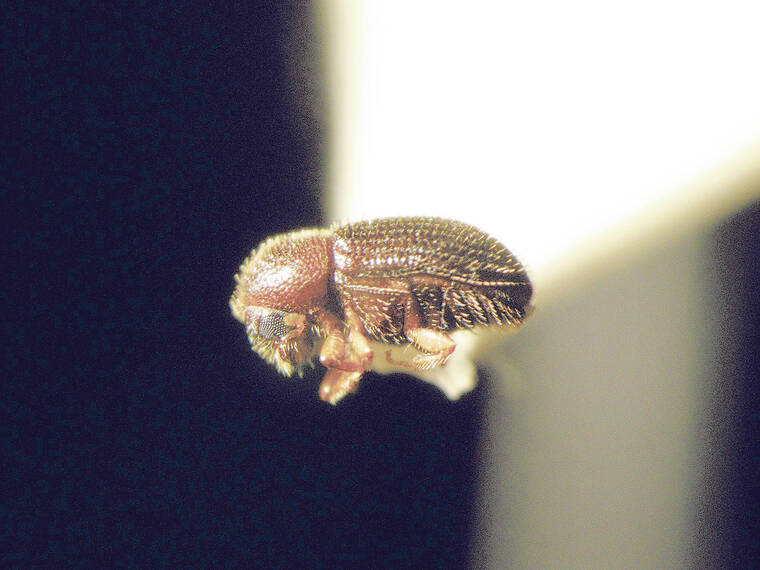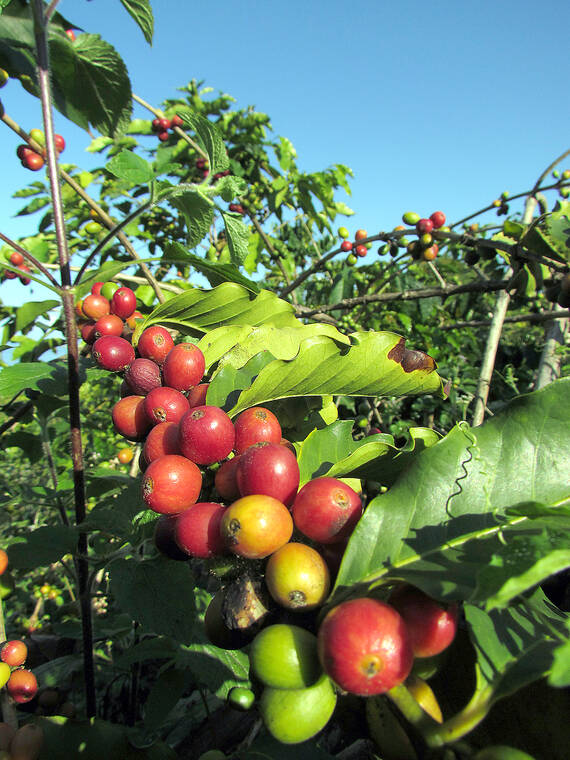Officials are proposing the release of a parasitoid wasp from Africa to assist in the fight against the invasive coffee berry borer.
The University of Hawaii College of Tropical Agriculture and Human Resources (CTAHR) in collaboration with the U.S. Department of Agriculture’s Agricultural Research Service is looking for approval to release Phymastichus coffea, a parasitoid wasp from Kenya, for biological control of coffee berry borer, Hypothenemus hampei. To date, P. coffea has been released in 12 countries as a classical biological control agent.
The coffee berry borer (CBB) is the most destructive insect pest of coffee globally, according to a draft environmental assessment published Dec. 8. Though endemic to Central Africa, CBB is now found in almost every coffee-producing country in the world.
In 2010, it first invaded Hawaii Island where high quality coffee is the second largest cash crop, valued at more than $55 million during the 2020-21 season. Since, the destructive beetle has invaded coffee on the islands of Oahu, Maui and Kauai resulting in crop loss estimated at $7.7 million.
“CBB has had the effect of making coffee farming more intensive and less profitable: damage causes significant losses in yield and alters the flavor profile of salvageable coffee beans. If left unmanaged, CBB can damage up to 90% of the crop,” the draft EA reads.
The release of the draft environmental assessment, which anticipates a finding of no significant impact for the proposal, kicked off a 30-day public comment period. Input is due by Jan. 9, 2023, to the proposing/consulting agency as well as the consultant.
Suzanne Shriner, president of the Kona Coffee Farmers Association, said the biological control method proposed by the state and USDA will be an improvement from the current methods farmers are using to reduce CBB on their properties, such as Beauveria bassiana, an entomopathogenic fungus. Subsidies for the insecticide recently dried up as well.
“None of us are happy about having to spray a pesticide on our trees, which is what we are doing now,” said Shriner. “The wasp reduces the need to spray, so it’s good for our neighbors who don’t like things sprayed on trees and it is good for us. It reduces our cost, which are several thousands of dollars per acre per year to control CBB.”
The small, parasitic wasp would assist in controlling CBB as the wasp larvae feed on adult CBB causing beetle death before the pest can penetrate the coffee berry and lay eggs.
“It has been proven very effective in coffee growing nations around the world. Columbia has used it for 20 years. They have released this wasp all across South America,” said Shriner.
The state began studying the non-stinging wasp under a 2018 permit. Specimens from Columbia were shipped to a certified quarantine insect containment facility managed by the USDA Forest Service at Hawaii Volcanoes National Park and incubated in controlled climate chambers where they were were studied.
Researchers found that the prospective biological control agent likely would have no negative impacts on public health. “In addition to its natural host, coffee berry borer, P. coffea was found to attack four other species in the genus Hypothenemus. The parasitoid did not attack any of the native and beneficial beetles tested, the draft EA reads.
“This wasp had no interest in any of our natives. It really only went after CBB and had a little interest in tropical nut borer, which is an invasive species that goes after the macadamia nut. So the mac nut farmers will like it too,” Shriner said. “The CBB is about the size of a sesame seed and the wasp is about half its size. It is so small, nobody is going to see this wasp.”
If Phymastichus coffea is approved for release, Colombia will supply wasps for the initial releases. Current plans call for the wasp to first be released in South Kona, the main coffee growing region in Hawaii that is also close to the USDA ARS laboratory and University of Hawaii experiment station that will facilitate monitoring.
Current plans call for the first release of the wasp at Greenwell Farms in Kealakekua. Other sites may also be selected depending on the number of parasitoids available with long-term plans calling for the release the of the wasp on all islands where CBB occurs.
Shriner said with the addition of coffee leaf rust, CBB has put a huge burden on coffee farmers to handle two invasive issues, and the wasp would be a good thing.
“It is a great tool in our tool belt,” she said.




